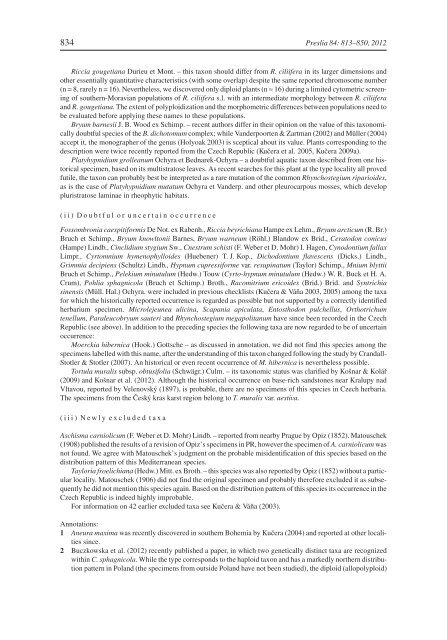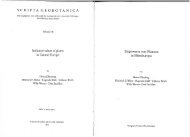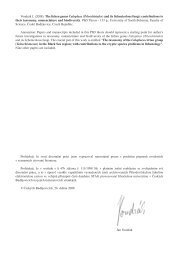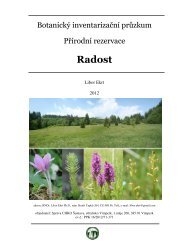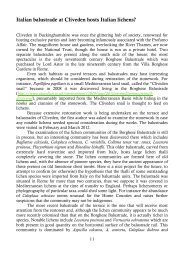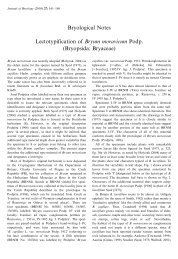Bryophyte flora of the Czech Republic: updated checklist and Red ...
Bryophyte flora of the Czech Republic: updated checklist and Red ...
Bryophyte flora of the Czech Republic: updated checklist and Red ...
Create successful ePaper yourself
Turn your PDF publications into a flip-book with our unique Google optimized e-Paper software.
834 Preslia 84: 813–850, 2012<br />
Riccia gougetiana Durieu et Mont. – this taxon should differ from R. ciliifera in its larger dimensions <strong>and</strong><br />
o<strong>the</strong>r essentially quantitative characteristics (with some overlap) despite <strong>the</strong> same reported chromosome number<br />
(n = 8, rarely n = 16). Never<strong>the</strong>less, we discovered only diploid plants (n ≈ 16) during a limited cytometric screening<br />
<strong>of</strong> sou<strong>the</strong>rn-Moravian populations <strong>of</strong> R. ciliifera s.l. with an intermediate morphology between R. ciliifera<br />
<strong>and</strong> R. gougetiana. The extent <strong>of</strong> polyploidization <strong>and</strong> <strong>the</strong> morphometric differences between populations need to<br />
be evaluated before applying <strong>the</strong>se names to <strong>the</strong>se populations.<br />
Bryum barnesii J. B. Wood ex Schimp. – recent authors differ in <strong>the</strong>ir opinion on <strong>the</strong> value <strong>of</strong> this taxonomically<br />
doubtful species <strong>of</strong> <strong>the</strong> B. dichotomum complex; while V<strong>and</strong>erpoorten & Zartman (2002) <strong>and</strong> Müller (2004)<br />
accept it, <strong>the</strong> monographer <strong>of</strong> <strong>the</strong> genus (Holyoak 2003) is sceptical about its value. Plants corresponding to <strong>the</strong><br />
description were twice recently reported from <strong>the</strong> <strong>Czech</strong> <strong>Republic</strong> (Kučera et al. 2005, Kučera 2009a).<br />
Platyhypnidium grolleanum Ochyra et Bednarek-Ochyra – a doubtful aquatic taxon described from one historical<br />
specimen, based on its multistratose leaves. As recent searches for this plant at <strong>the</strong> type locality all proved<br />
futile, <strong>the</strong> taxon can probably best be interpreted as a rare mutation <strong>of</strong> <strong>the</strong> common Rhynchostegium riparioides,<br />
as is <strong>the</strong> case <strong>of</strong> Platyhypnidium mutatum Ochyra et V<strong>and</strong>erp. <strong>and</strong> o<strong>the</strong>r pleurocarpous mosses, which develop<br />
pluristratose laminae in rheophytic habitats.<br />
(ii) Doubtful or uncertain occurrence<br />
Fossombronia caespitiformis De Not. ex Rabenh., Riccia beyrichiana Hampe ex Lehm., Bryum arcticum (R. Br.)<br />
Bruch et Schimp., Bryum knowltonii Barnes, Bryum warneum (Röhl.) Bl<strong>and</strong>ow ex Brid., Ceratodon conicus<br />
(Hampe) Lindb., Cinclidium stygium Sw., Cnestrum schisti (F. Weber et D. Mohr) I. Hagen, Cynodontium fallax<br />
Limpr., Cyrtomnium hymenophylloides (Huebener) T. J. Kop., Dichodontium flavescens (Dicks.) Lindb.,<br />
Grimmia decipiens (Schultz) Lindb., Hypnum cupressiforme var. resupinatum (Taylor) Schimp., Mnium blyttii<br />
Bruch et Schimp., Pelekium minutulum (Hedw.) Touw (Cyrto-hypnum minutulum (Hedw.) W. R. Buck et H. A.<br />
Crum), Pohlia sphagnicola (Bruch et Schimp.) Broth., Racomitrium ericoides (Brid.) Brid. <strong>and</strong> Syntrichia<br />
sinensis (Müll. Hal.) Ochyra. were included in previous <strong>checklist</strong>s (Kučera & Váňa 2003, 2005) among <strong>the</strong> taxa<br />
for which <strong>the</strong> historically reported occurrence is regarded as possible but not supported by a correctly identified<br />
herbarium specimen. Microlejeunea ulicina, Scapania apiculata, Entosthodon pulchellus, Orthotrichum<br />
tenellum, Paraleucobryum sauteri <strong>and</strong> Rhynchostegium megapolitanum have since been recorded in <strong>the</strong> <strong>Czech</strong><br />
<strong>Republic</strong> (see above). In addition to <strong>the</strong> preceding species <strong>the</strong> following taxa are now regarded to be <strong>of</strong> uncertain<br />
occurrence:<br />
Moerckia hibernica (Hook.) Gottsche – as discussed in annotation, we did not find this species among <strong>the</strong><br />
specimens labelled with this name, after <strong>the</strong> underst<strong>and</strong>ing <strong>of</strong> this taxon changed following <strong>the</strong> study by Cr<strong>and</strong>all-<br />
Stotler & Stotler (2007). An historical or even recent occurrence <strong>of</strong> M. hibernica is never<strong>the</strong>less possible.<br />
Tortula muralis subsp. obtusifolia (Schwägr.) Culm. – its taxonomic status was clarified by Košnar & Kolář<br />
(2009) <strong>and</strong> Košnar et al. (2012). Although <strong>the</strong> historical occurrence on base-rich s<strong>and</strong>stones near Kralupy nad<br />
Vltavou, reported by Velenovský (1897), is probable, <strong>the</strong>re are no specimens <strong>of</strong> this species in <strong>Czech</strong> herbaria.<br />
The specimens from <strong>the</strong> Český kras karst region belong to T. muralis var. aestiva.<br />
(iii) Newly excluded taxa<br />
Aschisma carniolicum (F. Weber et D. Mohr) Lindb. – reported from nearby Prague by Opiz (1852). Matouschek<br />
(1908) published <strong>the</strong> results <strong>of</strong> a revision <strong>of</strong> Opiz’s specimens in PR, however <strong>the</strong> specimen <strong>of</strong> A. carniolicum was<br />
not found. We agree with Matouschek’s judgment on <strong>the</strong> probable misidentification <strong>of</strong> this species based on <strong>the</strong><br />
distribution pattern <strong>of</strong> this Mediterranean species.<br />
Tayloria froelichiana (Hedw.) Mitt. ex Broth. – this species was also reported by Opiz (1852) without a particular<br />
locality. Matouschek (1906) did not find <strong>the</strong> original specimen <strong>and</strong> probably <strong>the</strong>refore excluded it as subsequently<br />
he did not mention this species again. Based on <strong>the</strong> distribution pattern <strong>of</strong> this species its occurrence in <strong>the</strong><br />
<strong>Czech</strong> <strong>Republic</strong> is indeed highly improbable.<br />
For information on 42 earlier excluded taxa see Kučera & Váňa (2003).<br />
Annotations:<br />
1 Aneura maxima was recently discovered in sou<strong>the</strong>rn Bohemia by Kučera (2004) <strong>and</strong> reported at o<strong>the</strong>r localities<br />
since.<br />
2 Buczkowska et al. (2012) recently published a paper, in which two genetically distinct taxa are recognized<br />
within C. sphagnicola. While <strong>the</strong> type corresponds to <strong>the</strong> haploid taxon <strong>and</strong> has a markedly nor<strong>the</strong>rn distribution<br />
pattern in Pol<strong>and</strong> (<strong>the</strong> specimens from outside Pol<strong>and</strong> have not been studied), <strong>the</strong> diploid (allopolyploid)


